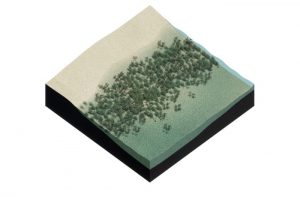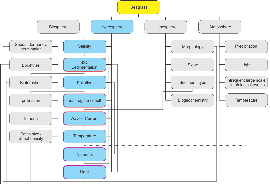Hydrosphere (water on or near the earth) – seagrass
Fig. 4. Habitat requirements seagrass hydrosphere
Salinity: Seagrasses are able to tolerate a large salinity range typical for most coastal areas. Note, however, that situations do exist where a too high or too low salinity is a limiting factor for seagrasses.
SSC/Sedimentation: The ability of seagrasses to tolerate sedimentation is very species-dependent. Seagrasses with short leaves are more sensitive to sedimentation than seagrasses with longer leaves. Yet, small pioneer species usually have the capacity of fast (re)colonisation of the sea floor. The larger climax species that make the largest contribution to coastal stability will not recover easily once they have disappeared. The leaf growth rate determines if a species can keep up with vertical sediment accretion. A rule of thumb is that if more than 50% of the total leaf length is covered with sediment, the seagrass bed will disappear. The ability of seagrasses to cope with sedimentation also depends on whether light availability is sufficient to sustain (increased) growth. If light is not sufficient, which often coincides with high levels of suspended sediments, or if energy reserves are depleted, seagrasses will die. On the other hand, a certain level of sediment input is required to counteract erosion, to keep up with sea level rise and to contribute to healthy seagrass development.
Pollution: Polluted areas are less suitable for the development of a healthy seagrass ecosystem. Pollutants may have directly affect seagrass metabolism and physiology, or indirectly the physiology of other biological components that are an important link in the ecological functioning of seagrass beds.
Tidal regime and depth: Water depth and light availability at the sea floor are directly correlated. In clear waters, seagrasses may extend into greater depths than in turbid waters. Superimposed is the tidal regime, which is very location-specific. In addition, the tidal regime is linked with hydrodynamic energy and turbulence. Seagrasses are known for their ability to reduce wave and current energy and to capture sediment and organic particles, thus reducing turbidity and preventing erosion of the coastal environment. As this makes this environment better suited for seagrass establishment and may lead to the expansion of the seagrass area, we have a positive feedback mechanism here. Currents and waves and tidal movement are responsible for the supply of sediment and organic particles. Too much hydrodynamic energy may prevent the establishment of seagrass beds and the positive feedback, or destroy existing seagrass beds by erosion and increased turbidity. Too little hydrodynamic energy may result in too muddy sediments and allow organic inputs from land run-off to increase the organic sediment content to levels unfavourable to seagrass. Hydrodynamic energy may mix this organic matter over the water column and keep it away from the seagrass bed. Positive feedback not only depends on hydrodynamics, but also on bed composition and shoot density. It varies with species and community composition and is therefore related to the succession phase of the seagrass bed. In addition, seagrasses often occur in intertidal areas and can survive without being submerged for some time, depending on the expose to sun and high temperatures.
Waves and currents: For the initial establishment of a seagrass bed a relatively sheltered location with clear water seems important. Once developed, higher levels of hydrodynamic energy may have a positive effect on maintaining a healthy balance between positive feedback effects and prevention of mud and organic matter accumulation (see tidal regime and depth). Natural succession, starting with (human-introduced) seagrass pioneer species and (active) introduction of species characteristic for next succession phases seems the most promising approach, especially if this coincides with the development of favourable biogeochemical conditions.
Water temperature: Temperature controls the rate of many physiological processes. Seagrass metabolism increases with increasing temperature. This also holds for other biological processes in the seagrass system, e.g. microbial activity and faunal respiration. In general, temperature increase comes with increased energy and oxygen consumption. This ultimately translates into higher light requirements at higher temperatures. Very high temperatures, which may occur in stagnant intertidal pools at low tide, may lead to physiological damage and protein denaturation.
Nutrients: Seagrasses are rooted marine macrophytes. With their roots and leaves they may scavenge both the bed and the water column for nutrients. N and P requirements of seagrasses, compared to their carbon requirements, is much lower than for most algae species. This makes seagrasses good competitors in nutrient-poor environments. As nutrient availability increases while other parameters are not limiting, the production of seagrasses increases. Yet, their competitive strength decreases in that case, especially if water column nutrient concentrations increase. Unlike most ephemeral (macro) algae, seagrasses are fixed to the sediment and cannot float to the water surface. Algae may occupy the entire water column and, moreover, may colonize seagrass leaves. This results in reduced light availability for seagrasses and may eventually lead to disappearance (see Epiphytes). Increased nutrient availability in the sediment may benefit seagrass development as long as it does not lead to increased nutrient concentrations in the water column. These nutrients may originate from fresh groundwater inputs, which may wrongfully suggest that seagrasses grow better at lower salinities.
Nutrient availability should be such that it offers competitive advantage for seagrasses. Nutrient concentrations are the result of import (e.g. terrestrial run-off, groundwater), production (e.g. microbial activity, leaching, excretion, defecation), export (e.g. with currents) and consumption (both biological and chemical). Nutrient concentration is not necessarily a measure for nutrient availability. In situations where nutrient import, production, export and consumption processes are tightly coupled, nutrient availability may be considerable while nutrient concentrations in the water or the bed are very low, even below detection limits. Assessment of nutrient availability, especially at low nutrient concentrations, requires insight into complex fluxes. In general, high nutrient concentrations are unfavourable for seagrass growth. An exception is made for seagrass communities that can survive in highly dynamic environments that prevent settlement and colonization of algae.
Light: One of the most important factors determining seagrass growth is light availability. The amount of light reaching the photosynthetic surface of seagrasses depends to a large extent on:
- Geographic location and depth
- Season
- Turbidity (hydrodynamics and sediment type)
- Epiphytes (eutrophication)


